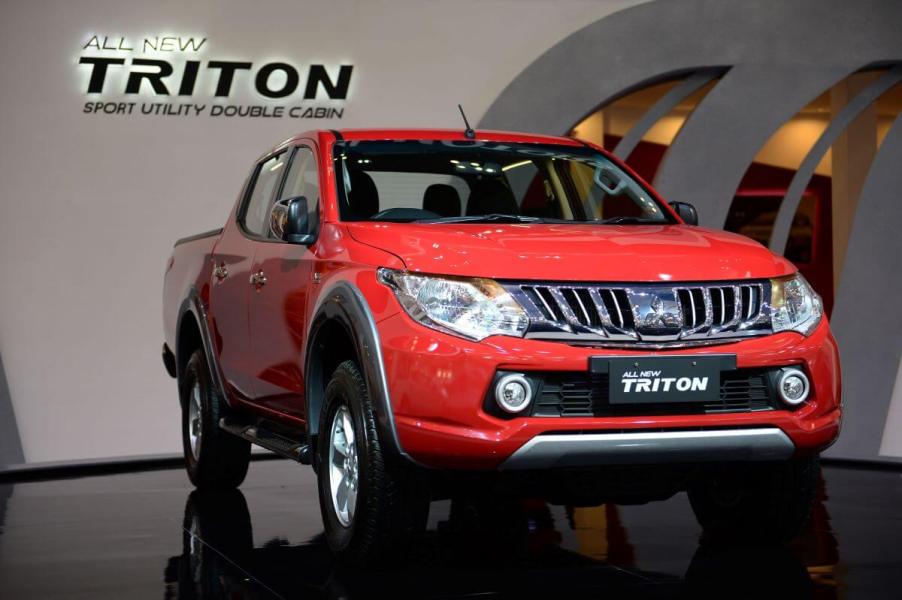
The History of the Mitsubishi Triton Truck and Its Many Monikers
Though Mitsubishi has an extensive history manufacturing trucks, the brand isn’t synonymous with American consumers for being a prolific pickup producer. Then again, even its fellow Japanese automakers like Honda, Toyota, or Nissan are often overshadowed by pickups from the Big Three, namely the Ford F-150, Chevy Silverado, and Ram 1500. However, Mitsubishi has a storied and long-running history of a pickup truck nameplate, the Triton, though that wasn’t its original name.
The Triton debuts in 1978 as the Forte and L200
Mitsubishi made its debut in the midsize pickup segment in 1978 with its first one-ton pickup. ‘Bishi’s first one-ton truck carried was sold as the Forte (curiously, Mitsubishi chose this moniker as it means “strong” in Italian) in the Japanese market, but exported models were also known as the Mitsubishi Truck and L200, Mitsubishi notes. The L200, as it was then known in North America, made its debut in 1979.
No matter the moniker, the Mitsubishi pickup was only available in a single-cab configuration. A part-time four-wheel drive option was added for the 1980 model year. It was sold in North America with either a 2.0-liter or an optional 2.6-liter engine in North America. Both engines continued to power Mitsubishi’s pickup through its second generation, which kicked off in 1986 and carried even more nameplates than the original model.
The Mitsubishi Triton’s evolution and many monikers
The Mitsubishi Triton’s second generation spanned the 1986 through 1994 model years. In addition to revised styling, the second-gen model was offered in three body types, a single cab, extended cab, and double cab, with short and long/extended body styles available.
The Triton’s second iteration was still dubbed the L200 in Japan, though it carried many other nameplates. It was called the Mitsubishi Mighty Max in North America, though it was also sold under Dodge as the Ram 50. The double cab version was sold as the Strada in Japan in 1991. The Colt nameplate, applied to various Mitsubishi models, was also used for the Triton in the South African market. The Triton has also carried the Storm, Magnum, and Strakar nameplates throughout its history.
Mitsubishi pulled the Mighty Max and Ram 50 from the U.S. market in 1996. Still, the L200/Strada soldiered on with the debut of its third generation in 1996, where it was sold in Asia, Europe, Oceania, Latin America, the Middle East, and Africa. The third-gen model was larger overall and debuted a new 2.5-liter turbodiesel engine and “Easy Select” four-wheel drive system.
The Triton nameplate was introduced with the model’s fourth generation in 2005, the same year it was introduced in Thailand. The fifth generation was introduced in 2014, featuring a choice of turbodiesel and gasoline-powered engines, while a six-speed manual and five-speed automatic debuted for the pickup.
The modern Triton and its upcoming new generation
The Mitsubishi Triton remains forbidden fruit in the U.S., but the pickup continues to be sold primarily in Asian and Oceanic markets. However, it’s surprisingly still not sold in Mitsubishi’s home country.
The 2023 Triton serves as the last model year of the truck’s current generation. It’s powered by a 2.4-liter turbodiesel engine, and like its predecessor, it’s available in either single, extended, or double-cab configurations with either a manual or automatic transmission. Depending on the market, it competes with other non-U.S.-available models like the Toyota Hilux, Nissan Navara, Mazda BT-50, and the Ford Ranger.
Since we can’t have a go behind the wheel, at least stateside, Australian publication CarExpert notes the 2023 Triton has plenty of positives, but it’s also aging. That’s what makes the upcoming 2024 Mitsubishi Triton an exciting proposition.
Mitsubishi recently unveiled the next-gen Triton/L200, and it’s an almost entirely new pickup throughout. It will be motivated by a 2.4-liter turbodiesel delivering three outputs from 146 to 201 horsepower with a six-speed auto or manual transmission, two- or four-wheel drive, and several trim options. What remains is a ladder-on-frame construction and rear leaf springs with a revised front double-wishbone suspension and larger heavy-duty shocks.
Though there have been some murmurings about the Triton making its way to the U.S. — where it could undoubtedly make a splash — so far, Mitsubishi has confirmed no such plans.




